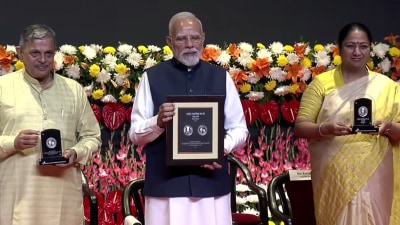Growing trees outside forests can offer environmental, socio-economic benefits: WRI India research
The researchers analysed the incentives of the implementation of trees outside forests in six states -- Gujarat, Karnataka, Maharashtra, Odisha, Punjab and Telangana -- to identify enabling conditions that can spur its expansion as well as the impediments.
 The letter accessed by the indianexpress.com stated that Singh requested the additional chief secretary to direct the revenue department to hand over the notified forests to the jurisdictional range forest officer. (Representational)
The letter accessed by the indianexpress.com stated that Singh requested the additional chief secretary to direct the revenue department to hand over the notified forests to the jurisdictional range forest officer. (Representational)A new paper by research organisation World Resources Institute (WRI) India shows how growing trees outside forests (ToF), particularly agroforestry, a landscape technique where farmers add trees to their land-and in and near cities, can offer manifold environmental and socioeconomic benefits.
In 2014, India became the first country to come up with a national agroforestry policy. The research stated that India’s policy framework provides multiple incentives that promote agroforestry, urban forestry and other approaches to increase the number of trees outside forests but despite the enabling policy conditions, farmers and other practitioners still struggle to sustain and enjoy the benefits of these systems.
The researchers Marie Duraisami, Ruchika Singh and Swati Chaliha analysed the incentives of the implementation of trees outside forests in six states — Gujarat, Karnataka, Maharashtra, Odisha, Punjab and Telangana — to identify enabling conditions that can spur its expansion as well as the impediments.
Speaking with The Indian Express, Ruchika Singh, who is also the director of Sustainable Landscapes and Restoration, WRI India, said: “There are several reasons for the slow uptake of trees-outside-forest systems like agroforestry despite several enabling monetary and non-monetary incentives at the national and sub-national levels. Key barriers that emerged from our analysis in six states in India are: lack of extension services for supporting farmers, knowledge gaps on trees outside forest (ToF) models and tree species, gaps in the regulatory environment, inadequate attention to land tenure and tree tenure, poor consideration around gender and social inclusion, lack of an enabling environment in ToF markets, lack of a landscape approach in restoration plans.”
Offering her insights about Karnataka, she explained: “To elaborate on a few, lack of quality planting material and standards is a crucial gap with issues related to the cost and quality of seedlings that farmers procure. In Karnataka, for instance, several stakeholders interviewed indicated that the quality of seedlings that farmers procure from private agencies was poor and of high rates. The lack of policy incentives for traditional agroforestry practices is also a challenge with greater incentives for monoculture and clonal variety and focus on developing market linkages for that. It disincentives the maintenance and restoration of native species. There is a need for greater focus on ecological safeguards while implementing these incentives and schemes.”
Karnataka through its flagship missions like the Krushi Aaranya Protsaha Yojana has supported agroforestry and showcased pathways in which different government departments such as forests, agriculture, horticulture, tribal welfare, water and rural development can work together to achieve ToF goals. It has also converged funds from MGNREGS and Pradhan Mantri Krishi Sinchayee Yojana (PMKSY). With a focus on developing decentralised farmer-focused implementation models, the Karnataka State Bamboo Mission conducts consultations with farmers to identify areas where paddy cultivation has become uneconomical and lands that have turned alkaline due to continuous cultivation of sugarcane. This approach has ensured farmers’ sustained interest and ecological restoration of degraded areas and the mission is trying to revive bamboo value chains, the research stated.
Singh added that the gaps in the regulatory environment are a critical barrier to the uptake of ToF systems. “Stakeholders from all the six states indicated that regulatory bottlenecks hinder the adoption of ToF models despite the enabling policies/schemes for scaling ToF. Although there is an emphasis on easing the process of exempting specific tree species from felling/harvest and transit regulations, state-level differences in policy and legal ambiguities create conflicts in transporting farm-grown timber across the state line. Another critical issue to address is land tenure and tree tenure – given, 35 per cent of India’s agricultural land is cultivated by tenant farmers (approximately 25 million rural households). The National agroforestry policy 2014 recognises secure land and tree tenure as a critical enabling condition. Concrete action on this is still lagging,” she said.
One of the recommendations stated in the research is the need for designing incentives to protect existing ToF and to promote traditional ToF models with native species. “Designing plans that are steered by local priorities and designing incentives to protect existing ToF and to promote traditional ToF models with native species is critical. Stakeholder interviews with farmers in Karnataka indicated a strong understanding of the benefits of agroforestry and recognition of the resilience of agroforestry systems to drought and several other benefits like checking soil erosion, increasing soil moisture content, and improving groundwater retention. In rainfed systems, these benefits increase the productivity of the land. Farmers could be incentivised to grow native species agroforestry models by exploring the design of, for instance, payment of ecosystem services for better uptake of these practices,” Singh explained.







